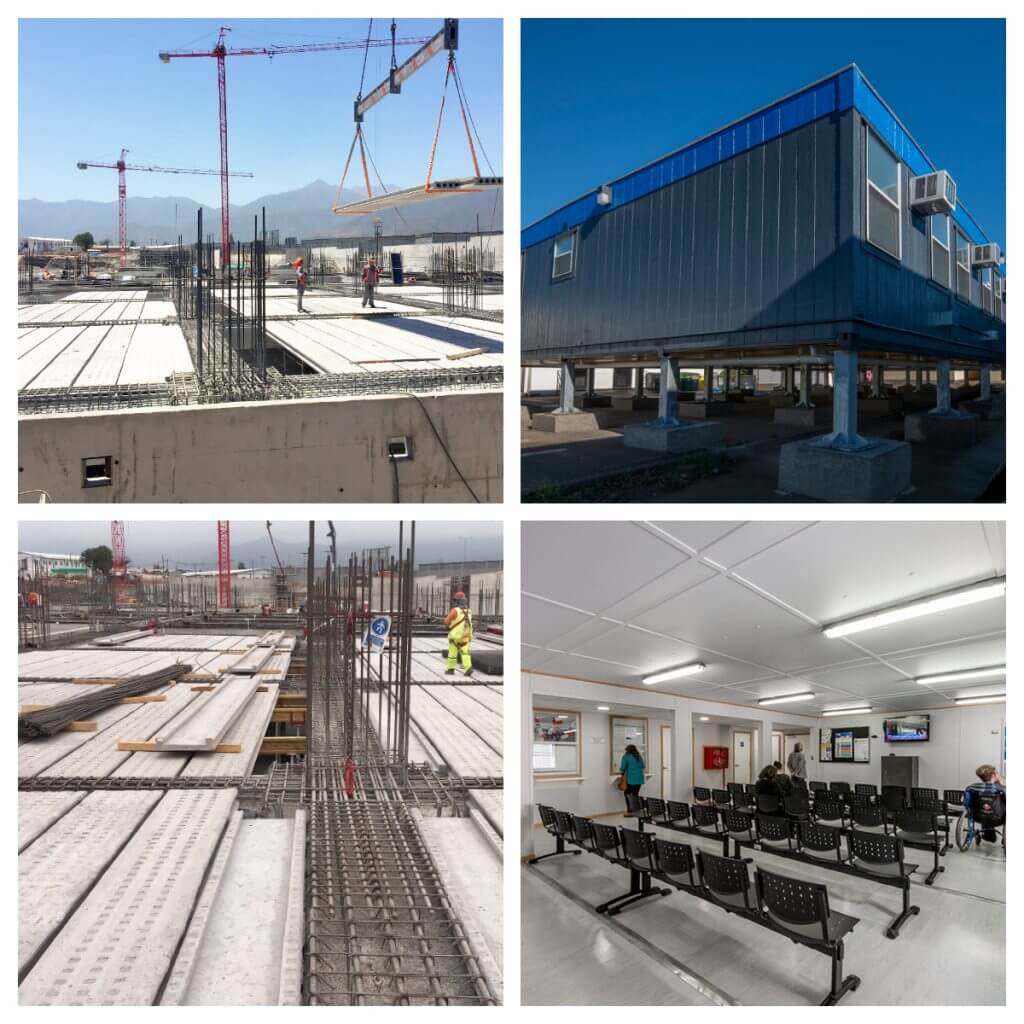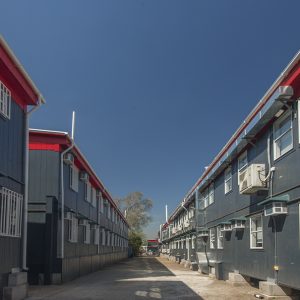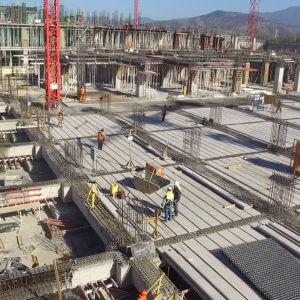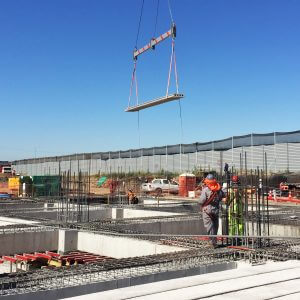6 April, 2020

Our partners CCI Tecno Fast, VMB Ingeniería Estructural and Hormipret discuss their experiences in hospital industrialization.
The accelerated construction of a hospital in Wuhan, China, was a true containment shield against the dreaded Covid-19, which now threatens Chile. Our country has not yet experienced the cold winter temperatures that, as is traditional, bring with it an increase in respiratory diseases, but the number of infections by coronavirus already has the authorities thinking about how to increase hospital beds, if necessary.
In this hypothetical scenario, Chile has the technology to imitate the Chinese example and could well build a hospital in less than two weeks. This is what Mario Yáñez, Engineering Manager of Tecno Fast, estimates, who anticipates that, in cities like Chillán, it is feasible to install such an enclosure in about 12 days.
The modular solutions company was responsible for the Salvador Hospital, which has been operating for three years and which exceeds 7 thousand m2 in facilities: “There are two laboratories, an ophthalmology center, pediatric medicine and a series of other services distributed on two floors”, Mario Yáñez explains. In addition, the company built two psychiatric hospitals in San Felipe, family health centers (Cesfam) in the Valparaíso Region and reference health centers (CRS) in La Florida and Los Andes.
Tecno Fast currently has a stock of more than 1,600 modular units that would allow up to four hospitals with 300 beds each, so the company is attentive to the contingency and the call of the health authority. “The hospital infrastructure is totally feasible and is practically immediate, since spaces that are available in the same areas of hospitals are used to lift it. There are no demolitions or noise or dust contamination, it is a solution that can be delivered up to two and three floors, “says the executive.
Tecno Fast even takes care of the necessary climate systems in hospital facilities. In fact, its specialists built a morgue in El Salvador with 18 chambers and have also manufactured surgical wards. Today they are in talks with Bogotá to build a 2,000-bed hospital.


Quillota-Petorca Hospital
Another industrialized solution is that of the Quillota-Petorca Hospital, which was pre-certified CES in 2018, with an estimated energy consumption in design of 137 kWh / m2, and is in the process of being certified, in which seismic isolation systems were used, slabs honeycombs and pre-slabs placed on the insulation level. “The blueprints did not consider the explicit use of precast slabs, so to avoid potential contractual conflicts their use was limited only to the additional slab that was generated by moving the level of insulation from the subway ceiling to a basal insulation solution ”Explains Ian Watt, manager of VMB Ingeniería Estructural, a partner company of the Industrialized Construction Council (CCI), promoted by Construye2025.
En una superficie de aproximadamente 16 mil m2, jugó un rol crucial la empresa de prefabricados de hormigón pretensado y especialista en losas, Hormipret (también socia del CCI), con dos líneas de productos: AlveoLosa® y PreLosa®. “Este último brindó solución al encuentro losa–capiteles, al no requerir necesariamente una ménsula de apoyo, generándose su unión, por medio de estribos de enlace. Este prefabricado, posee características técnicas importantes para la solución de los entrepisos industrializados pudiendo aportar, ademas, aislación térmica y acústica”, detalla Tatiana Martínez, gerente general de Hormipret.
The project required deliveries of between 1,200 m² and 1,350 m² per week, in addition to the provision for transfer and assembly at night. “This allowed and favored that any activity or task subsequent to the installation of our prefabricated buildings (enclosure, installations and concreting, among others) was not affected, generating more significant advances for the construction company. For this, coordination between Hormipret and the professionals of the project was essential ”, adds the architect.
Modules of 8 × 8 in 90% of the project, duly identified and marked, favored assembly and traceability. In this area, all Hormipret slabs were manufactured in standard widths of 0.60m, which reduced the weight of the precast considerably, allowing the site to use the project’s tower cranes, without having to consider external cranes.
According to Ian Watt, the main complexity occurred because the authorization to consider the use of these elements was obtained late in the design process. “Ideally, when there is industrialized construction, the structure is arranged to benefit the performance of the precast elements, to fully exploit the increases in performance in time and materials that they can provide. But, in this case, it was only possible to incorporate it at the end, without the possibility of optimizing the structural modulations. As in any project, it was resolved with good coordination between the design team, the technical department of the construction company and the advice of technically trained suppliers, “he says.
In this regard, Tatiana Martínez recalls that when the project was already underway, the wet union of the slabs and the capital of the seismic isolation system had to be resolved, where due to the amount of enclosure it was not possible to generate support to receive the honeycomb slab, for which the use of PreLosa® was specified, which due to its geometry, did not necessarily need a support, generating the wet joint by means of link stirrups.
Another important point in the use of industrialized slabs is that the dead weight of the slab is reduced from the beginning of the project, when calculations are carried out with less seismic mass and total weight of the slab, which significantly reduces the dimensions of the structure.


Pending challenges
The main barrier to the industrialized construction of hospitals in Chile, according to Ian Watt, is that the elements are frequently prohibited in the bases and design criteria. In the few cases where they are not directly prohibited, most bidders avoid listing them, concerned that solutions will be rejected later. Tatiana Martínez agrees with him, who calls to promote the use of precast in all public works in the country. “The comparative advantages over traditional systems are proven and widely used in developed countries, in different materials,” says the Hormipret manager.
Less steel, less concrete to be poured on site, less labor and considerable speed of execution underpin the paradigm shift. “The decrease in the construction budget in these items would mean significant savings in the construction of infrastructure and, in the case of hospitals, the speed of construction would shorten delivery times for the care of their patients,” added the architect.
In a scenario like the current one, where the numbers of contagion by coronavirus increase daily, the opportunity opens for an in-depth evaluation of industrialization in construction. “Open up to new solutions as several countries have done and that means that the State must review regulations, professional skills, skilled labor and encourage construction companies to seek innovative constructive solutions for the development of their projects, thus improving the infrastructure and the building of the country ”, concludes Tatiana Martínez.
In this sense, both specialists agree that together with the willingness to innovate it is key to integrate the professionals who are part of the chain early, since the optimal development of the projects results in practical solutions that improve productivity and efficiency in construction works.